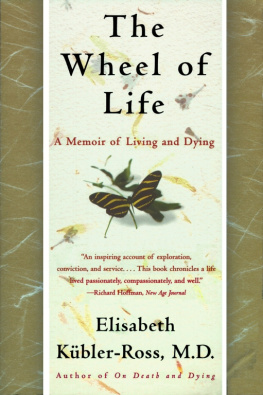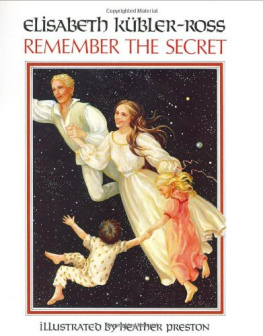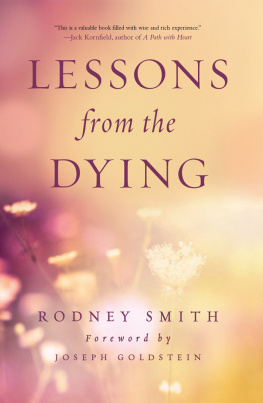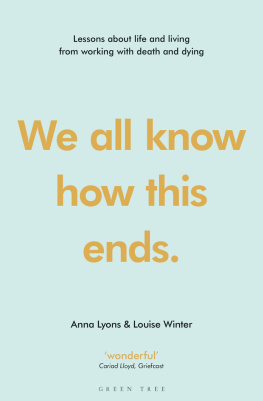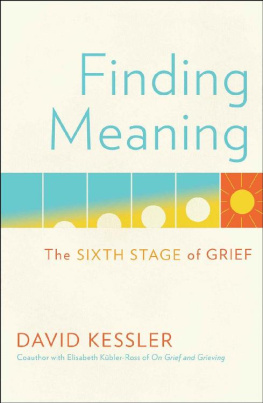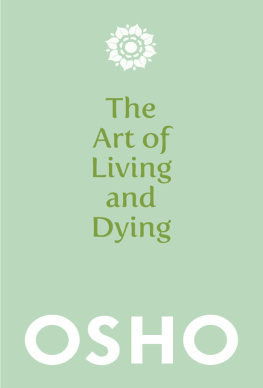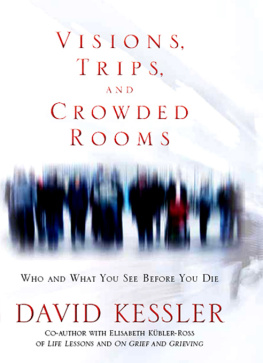
LIFE
LESSONS

OTHER BOOKS BY ELISABETH KBLER-ROSS AND DAVID KESSLER
On Grief and Grieving
OTHER BOOKS BY ELISABETH KBLER-ROSS
Why Are We Here ( Germany )
Longing to Go Back Home ( Germany )
Making the Most of the In-Between ( Poland )
Unfolding the Wings of Love ( Germany )
The Tunnel and the Light
On Life After Death
AIDS: The Ultimate Challenge
On Children and Death
Remember the Secret
Working It Through
Living with Death and Dying
To Live Until We Say Good-bye
The Dougy Letter ( Letters to a Dying Child )
Death: The Final Stage of Growth
Questions and Answers on Death and Dying
On Death and Dying
The Wheel of Life
OTHER BOOKS BY DAVID KESSLER
The Needs of the Dying
Visions, Trips and Crowded Rooms
You Can Heal Your Heart (with Louise Hay)


SCRIBNER
1230 Avenue of the Americas
New York, NY 10020
www.SimonandSchuster.com
Copyright 2000 by Elisabeth Kbler-Ross Family Limited Partnership and David Kessler, Inc.
All rights reserved, including the right of reproduction in whole or in part in any form.
First Scribner trade paperback edition 2003
SCRIBNER and design are trademarks of Macmillan Library Reference USA, Inc., used under license by Simon & Schuster, the publisher of this work.
DESIGNED BY ERICH HOBBING
Set in Granjon
The Library of Congress has cataloged the Scribner edition as follows:
Kbler-Ross, Elisabeth.
Life lessons: two experts on death and dying teach us about the mysteries of life and living / Kbler-Ross and David Kessler
p. cm.
1. Conduct of life. 2. Death. I. Kessler, David, date. II. Title.
BJ1581.2.K83 2000
170'.44dc21 00057387
ISBN 0-684-87074-6
0-684-87075-4 (Pbk)
ISBN-13: 978-0-6848-7075-5 (Print)
ISBN-13: 978-1-4391-3086-5 (ebook)
For
Sylvia Anna
my first grandchild
A gift from
my daughter Barbara
Elisabeth
For
my sons
Richard and David
David
ACKNOWLEDGMENTS
T o Joseph, who made it possible to write another book. To Ana, who keeps my household going and allows me to stay home instead of going to a nursing home. And my children, Barbara and Kenneth, for keeping me going.
ELISABETH
F irst and foremost, my deep thanks to Elisabeth for the privilege of cowriting this book with you. Your wisdom, authenticity, and friendship have made it the experience of a lifetime. Thanks to Al Lowman at Authors and Artists for believing in the importance of this work. Your guidance, support, and friendship are true gifts in my life.
My gratitude to Caroline Sutton at Simon & Schuster for her insight, care, and masterful editing. Thanks also to Elaine Chaisson, Ph.D., B. G. Dilworth, Barry Fox, Linda Hewitt, Christopher Landon, Marianne Williamson, Charlotte Patton, Berry Perkins, Teri Ritter, R.N., Jaye Taylor, James Thommes, M.D., and Steve Uribe, M.F.T., who have each in their special ways made a contribution to this book.
DAVID
CONTENTS
A MESSAGE FROM ELISABETH
W e all have lessons to learn during this time called life; this is especially apparent when working with the dying. The dying learn a great deal at the end of life, usually when it is too late to apply. After moving to the Arizona desert in 1995, I had a stroke on Mothers Day that left me paralyzed. I spent the next few years at deaths door. Sometimes I thought death would come within a few weeks. Many times, I was disappointed that it did not come, for I was ready. But I have not died because I am still learning the lessons of life, my final lessons. These lessons are the ultimate truths about our lives; they are the secrets to life itself. I wanted to write one more book, not on death and dying but on life and living.
Each of us has a Gandhi and a Hitler in us. I mean this symbolically. The Gandhi refers to the best in us, the most compassionate in us, while the Hitler to the worst in us, our negatives and smallness. Our lessons in life involve working on our smallness, getting rid of our negativity and finding the best in ourselves and each other. These lessons are the windstorms of life, they make us who we are. We are here to heal one another and ourselves. Not healing as in physical recovery, but a much deeper healing. The healing of our spirits, our souls.
When we talk about learning our lessons, were talking about getting rid of unfinished business. Unfinished business isnt about death. Its about life. It addresses our most important issues, such as Yes, I made a nice living but did I ever take time out to really live? Many people have existed, yet never really lived. And they expended tremendous amounts of energy keeping a lid on their unfinished business.
Since unfinished business is the biggest problem in life, its also the primary issue we address as we face death. Most of us pass on with a great deal of unfinished business; many of us have at least some. There are so many lessons to learn in life, its impossible to master them all in one lifetime. But the more lessons we learn the more business we finish, and the more fully we live, really live life. And no matter when we die, we can say, God, I have lived!
A MESSAGE FROM DAVID
I have spent a great deal of time with people at the edge of life. This work has been enriching and life expanding. I can trace much of my growth, psychologically, emotionally, and spiritually, to my work with the dying. While I am deeply grateful to those I have worked with and who have taught me so much, my lessons did not begin with them. Instead, they began many years ago with my own mothers death and continue to the present as I lose people I love.
During the past few years I have been preparing to say good-bye to a teacher, mentor, and dear, dear friend, Elisabeth. I have spent a great deal of time with her, being taught final lessons. Having taught me so much about my work with the dying, she was now facing death in her own life. She shared how she was feelingangry a lot of the timeand her views on life. She was completing her last book, The Wheel of Life, and I was writing my first, The Needs of the Dying. Even during this challenging time of her life she was profoundly helpful to me, dispensing advice on publishing, my patients, and life itself.
Many times, it was enormously hard for me to leave her house. We would say our good-byes, both believing that this would be the last time we would see each other. I would walk away in tears. It is so hard to lose someone who has meant so much, yet she said she was ready. But Elisabeth did not die; she slowly got better. She was not finished with life and it was clearly not finished with her.
In days long gone, the community would have gathering places where children and adults listened as the older men and women told stories of life, of lifes challenges and the lessons that can be drawn from the edge of life. People knew that sometimes our greatest lessons lie in our greatest pain. And they knew that it was important to the dying, as well as to the living, that these lessons be passed on. That is what I hope to do, pass on some of the lessons I have learned. Doing so ensures that the best parts of those who have died will live on.
Next page


